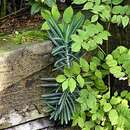Comments
provided by eFloras
Euphorbia lathyris is a very isolated species that is adventive in many parts of the world. It is probably native only in the Mediterranean region.
The seeds are used medicinally. The seed oil (ca. 50%) can also be widely used in industry, and there has been some work on the development of Euphorbia lathyris as a commercial crop, particularly by the selection of forms with indehiscent fruits.
- license
- cc-by-nc-sa-3.0
- copyright
- Missouri Botanical Garden, 4344 Shaw Boulevard, St. Louis, MO, 63110 USA
Description
provided by eFloras
Herbs, annual, erect, up to 1(-1.5) m tall. Rootstock a simple taproot, slightly swollen in seedlings, up to more than 20 cm × 3-7 mm thick; lateral roots thin and branched. Stem single, gray-green, smooth and glabrous. Leaves opposite, decussate; stipules absent; petiole absent; leaf blade linear-lanceolate, 6-15(-20) × 0.4-2.5 cm, glabrous, base ± clasping stem, margin entire, apex acuminate or acute; midrib prominent adaxially, lateral veins inconspicuous. Inflorescence a terminal pseudumbel, often compound, eventually broad and lax; primary involucral leaves (2-)4 or 5(or 6), slightly yellowish green, narrowly elliptic to ovate-elliptic, somewhat unequal, margin entire, base rounded, primary rays (3 or)4 or 5; cymes regularly many forked; cyathophylls 2, ovate-triangular, 3-8 × 2-4 cm, base truncate to clasping, margin entire, apex acuminate or acute. Cyathium subsessile; involucre subcampanulate, 2.5-4 × 2.5-3.5(-5) mm, lobes triangular-oblong, less repanded or lobed; glands 4, dark brown, transversely oblong-reniform with a club-shaped horn at each tip. Male flowers many, exserted from involucre. Female flower exserted from cup; ovary smooth, glabrous; styles free, slender and long, caducous; style arms 2-lobed. Capsule trigonous-globose, ca. 10 × 13-17 mm, smooth, glabrous. Seeds ovoid-globose to barrel-shaped, 5-8 × 4-6 mm, brown or gray-brown, with black-brown spots on surface, sharply rugulose; caruncle ca. 1.5 mm wide, yellowish, sessile, easily lost. Fl. Apr-Jul. 2n = 20*.
- license
- cc-by-nc-sa-3.0
- copyright
- Missouri Botanical Garden, 4344 Shaw Boulevard, St. Louis, MO, 63110 USA
Habitat & Distribution
provided by eFloras
Weed of cultivation. Anhui, Fujian, Gansu, Guangdong, Guangxi, Guizhou, Hainan, Hebei, Henan, Hubei, Hunan, Jiangsu, Jiangxi, Jilin, Liaoning, Nei Mongol, Qinghai, Shaanxi, Shandong, Shanxi, Sichuan, Xinjiang, Xizang, Yunnan, Zhejiang [N Africa, America, Asia, Europe].
- license
- cc-by-nc-sa-3.0
- copyright
- Missouri Botanical Garden, 4344 Shaw Boulevard, St. Louis, MO, 63110 USA

